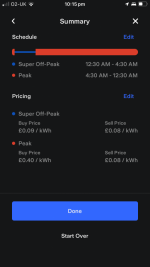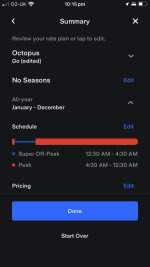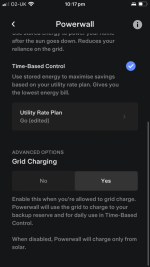It doesn't work with my set up, SyncEV 7.5Kw charger and Audi eTron GT, so I just use it as I would use Go with the timer on the SyncEV charger, just gives me an extra 2 hours cheap electric compared to Go, Octopus tried for a few months to get it working then just gave upI need to get off Go and onto intelligent as soon as they'll let all Zappi owners join, not just the Beta testers...
Pinball info
You are using an out of date browser. It may not display this or other websites correctly.
You should upgrade or use an alternative browser.
You should upgrade or use an alternative browser.
Doesn’t that disqualify you from their terms of use? We have 2x Kia eNiro’s which aren’t supported, but the Zappi is due to be immanently.It doesn't work with my set up, SyncEV 7.5Kw charger and Audi eTron GT, so I just use it as I would use Go with the timer on the SyncEV charger, just gives me an extra 2 hours cheap electric compared to Go, Octopus tried for a few months to get it working then just gave up
I've not even looked at tariffs yet - 1st job get the solar system up and running.
Don't forget the battery storage, the feed-in in the UK is much less than the costI've not even looked at tariffs yet - 1st job get the solar system up and running.
Ditto got my name down.I need to get off Go and onto intelligent as soon as they'll let all Zappi owners join, not just the Beta testers...
That said I’m ok with GO as my last couple of bills were around a tenner a month.
This is due to the fact they give me 8p feed in tariff that covers my daily charge or part of every day. They have however raised my nightime charge to 9p between 12:30 and 4:30.
I charge my car around 1-2 times a week during this time which equates to over 230mi in the tank.
I've not even looked at tariffs yet - 1st job get the solar system up and running.
Same. Go works well - car plus the PowerWall, 2 storage heaters, washing machine, and 300W background all overnight… peaks around 15-16kW. New MCB helps!Ditto got my name down.
That said I’m ok with GO as my last couple of bills were around a tenner a month.
This is due to the fact they give me 8p feed in tariff that covers my daily charge or part of every day. They have however raised my nightime charge to 9p between 12:30 and 4:30.
I charge my car around 1-2 times a week during this time which equates to over 230mi in the tank.
Intelligent would be marginally cheaper and have a slightly longer window for car charging and storage heaters.
The export on Intelligent is also nearly double GO.
Image wasn’t a sunny day.
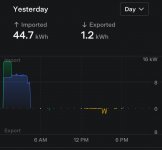
OK - system in and running.
Now trying to figure out a new provider/tariff that would allow me to charge batteries cheap overnight - no EV, so there doesn't seem to be much about, except Octopus Agile, which seems risky - especially with our daily pattern of usage (I dont want to be cooking my evening meal at 12:01 a.m.).
Anything else anyone is on or has come across?
Now trying to figure out a new provider/tariff that would allow me to charge batteries cheap overnight - no EV, so there doesn't seem to be much about, except Octopus Agile, which seems risky - especially with our daily pattern of usage (I dont want to be cooking my evening meal at 12:01 a.m.).
Anything else anyone is on or has come across?
Tell them you have an EV? I know of a good number of people (via Facebook Solar and battery discussion groups) who don’t own one but still access an EV tariff, just not an “intelligent” tariff that connects to the charger or car directly. I use GO. My mate uses EON Next Drive, which looks better on paper if you can stomach EON’s customer service and far less useful phone App. You’ll probably be using between 10-25kWh a night with 2 PW’s, depending on the solar predictions and your Solar panel performance. They charge at 5kW each so you’d easily fully charge both plus other stuff in 4hrs, and that’s EV-level amounts, which charge at up to 32A or 7-7.5kW.
I might just try it on Paul and see if i can get on it.Tell them you have an EV? I know of a good number of people (via Facebook Solar and battery discussion groups) who don’t own one but still access an EV tariff, just not an “intelligent” tariff that connects to the charger or car directly. I use GO. My mate uses EON Next Drive, which looks better on paper if you can stomach EON’s customer service and far less useful phone App. You’ll probably be using between 10-25kWh a night with 2 PW’s, depending on the solar predictions and your Solar panel performance. They charge at 5kW each so you’d easily fully charge both plus other stuff in 4hrs, and that’s EV-level amounts, which charge at up to 32A or 7-7.5kW.
I’m trying to figure out how you configure the tesla app to tell it when you’re on cheaper electricity - got me stumped at the mo.
There's Octopus Cozy which I'm on, it's designed for Heat Pumps but haven't asked me about mine, although it is currently getting installed.OK - system in and running.
Now trying to figure out a new provider/tariff that would allow me to charge batteries cheap overnight - no EV, so there doesn't seem to be much about, except Octopus Agile, which seems risky - especially with our daily pattern of usage (I dont want to be cooking my evening meal at 12:01 a.m.).
Anything else anyone is on or has come across?
Cheap rate is 4am to 7am and 1pm to 4pm, peak rate is 4pm to 7pm rest of the times it's about usual price.
Then sign up for their fixed export at 15p per kWh.
I am on octopus Flux. Set the tariff up in the Tesla Gateway and it learns your usage and charges the battery when cheapest, then imports or exports based on what is cheapest or best. The peak export rate means you could make money just by buying at the cheapest and selling at peak.
The solar generation during the day can be exported for the same price as filling your battery at super off peak, so you don’t have to worry about that either.
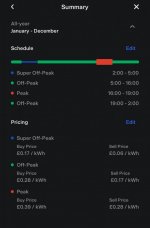
The solar generation during the day can be exported for the same price as filling your battery at super off peak, so you don’t have to worry about that either.

Settings > Utility rates - I exaggerate my day rate a bit to give it less reason to use grid then. Needs to be on Time based Control.I might just try it on Paul and see if i can get on it.
I’m trying to figure out how you configure the tesla app to tell it when you’re on cheaper electricity - got me stumped at the mo.
The setting to allow charge from
Grid takes a day or 2 to appear. I don’t know why! It’ll be under settings > PowerWall (at the bottom).
Attachments
Yes, the "Grid charging" option has appeared now - currently set to off as I am on a flat rate tariff.
Because I'm on a flat rate tariff - I originally set the app up for that - and when you hit "Edit" - it doesnt let you change to a different pricing model - I realised you need to hit "Start Over" and then select "Custom rate plan"
I was looking at octopus Agile - but I just can't see how it's possible for the tesla app to pick up the 1/2 hourly pricing and do the best thing - i.e. charge batteries from the grid when it's cheap or even being paid to charge, versus releasing back into the grid when you get paid the most?
Because I'm on a flat rate tariff - I originally set the app up for that - and when you hit "Edit" - it doesnt let you change to a different pricing model - I realised you need to hit "Start Over" and then select "Custom rate plan"
I was looking at octopus Agile - but I just can't see how it's possible for the tesla app to pick up the 1/2 hourly pricing and do the best thing - i.e. charge batteries from the grid when it's cheap or even being paid to charge, versus releasing back into the grid when you get paid the most?
PS - Octopus flux not listed when I pop in my postcode and look at all the available octopus tariffs - only go, cosy and agile offered
PS - Octopus flux not listed when I pop in my postcode and look at all the available octopus tariffs - only go, cosy and agile offered
Does this page give you the option when you put your postcode in?
Although that page says you have to be an existing customer before you can switch to it, but I think that was the same for the Cosy tariff I switched to as well.

Octopus Flux | Energy Tariff Designed for Solar & Batteries | Octopus Energy
Octopus Flux lets you sell your excess solar power using manual battery control. You’re in charge of when to import or export.
I was looking at octopus Agile - but I just can't see how it's possible for the tesla app to pick up the 1/2 hourly pricing and do the best thing - i.e. charge batteries from the grid when it's cheap or even being paid to charge, versus releasing back into the grid when you get paid the most?
A man of your talents... ?!
The Powerwall is designed to be left well alone, but if you intend to start making the most, have look here and maybe contact the site owner: https://dreamgreenhouse.com/projects/energy/gateway.php
(you might need Grid discharge to be enabled - was that allowed in your G99 response? Mine isn't).
Personally I like the predictability of GO - 4hrs OFFPEAK, the rest PEAK, so I can set and forget. I can't/don't write code though. Sometimes I wish I could.
also look at https://www.home-assistant.io/
tried that. once i put in postcode it doesn’t offer fluxDoes this page give you the option when you put your postcode in?
Although that page says you have to be an existing customer before you can switch to it, but I think that was the same for the Cosy tariff I switched to as well.

Octopus Flux | Energy Tariff Designed for Solar & Batteries | Octopus Energy
Octopus Flux lets you sell your excess solar power using manual battery control. You’re in charge of when to import or export.octopus.energy
I really don’t want to get into any of that. I’m actually shocked that the tesla app/gateway/powerwall is not capable of handling something like the agile tariff out-of-the-box. it’s a no brainer going forward.A man of your talents... ?!
The Powerwall is designed to be left well alone, but if you intend to start making the most, have look here and maybe contact the site owner: https://dreamgreenhouse.com/projects/energy/gateway.php
(you might need Grid discharge to be enabled - was that allowed in your G99 response? Mine isn't).
Personally I like the predictability of GO - 4hrs OFFPEAK, the rest PEAK, so I can set and forget. I can't/don't write code though. Sometimes I wish I could.
also look at https://www.home-assistant.io/
May be of interest to anyone with a SunSynk system. i had an odd issue where the grid would charge the batteries for 15 mis or so every 45 minutes without my telling it.
Solution and Closure Notes
This was saw tooth charge cycle that could have cost a lot of money if left:

This is the correct profile now after the 100% grid charge: -

It seems the route cause was that the batteries were too low or out of synch. And the system for some reason continually tried to partially recover them. But in doing so it set up a vicious circle that would, if gone unnoticed, have cost a fortune until we had enough sun to take them to 100% naturally.
Qs still with SunSynk
That said why did it not show a fault?
Why did it start to charge and stop before 100% reached and enter a loop?
Why did it even enter this state at all?
Why 22% and 24%, these are not settings I can see anywhere?
If i was a normal user, not looking for irregularities like this, i would have been paying a fortune for the grid to keep topping up the batteries a few percent more than they were until longer sunny days came around to naturally move the SOC to 100% and self-solve. Recall it entered a loop of conducting a 2.5kw charge from the grid, for 15 minutes, every 45 minutes or so. Just (so it seems) to lift the SOC a few percent from 22% to 24%. Once the percentage (24%) was reached the grid woudl stop charging and the batteries would start to discharge and the cycle continued until the PV kicked in. But as the PV never took the batteries to 100%, the cycle returned later once the SOC got to 22% again.
Only after I initiated a grid charge to 100% then later reconfigured it to go back to 20% again, did the issue resolve.
what should have happened is the system should have reported the issue, and then given the option to charge from grid or just charged anyway. Better still it should not have got into that state to begin with.
Solution and Closure Notes
This was saw tooth charge cycle that could have cost a lot of money if left:

This is the correct profile now after the 100% grid charge: -

It seems the route cause was that the batteries were too low or out of synch. And the system for some reason continually tried to partially recover them. But in doing so it set up a vicious circle that would, if gone unnoticed, have cost a fortune until we had enough sun to take them to 100% naturally.
Qs still with SunSynk
That said why did it not show a fault?
Why did it start to charge and stop before 100% reached and enter a loop?
Why did it even enter this state at all?
Why 22% and 24%, these are not settings I can see anywhere?
If i was a normal user, not looking for irregularities like this, i would have been paying a fortune for the grid to keep topping up the batteries a few percent more than they were until longer sunny days came around to naturally move the SOC to 100% and self-solve. Recall it entered a loop of conducting a 2.5kw charge from the grid, for 15 minutes, every 45 minutes or so. Just (so it seems) to lift the SOC a few percent from 22% to 24%. Once the percentage (24%) was reached the grid woudl stop charging and the batteries would start to discharge and the cycle continued until the PV kicked in. But as the PV never took the batteries to 100%, the cycle returned later once the SOC got to 22% again.
Only after I initiated a grid charge to 100% then later reconfigured it to go back to 20% again, did the issue resolve.
what should have happened is the system should have reported the issue, and then given the option to charge from grid or just charged anyway. Better still it should not have got into that state to begin with.
Have you got any option to check the voltages of the battery packs and each cell within them when this starts happening, SOC isnt the most accurate thing to go by with these storage systems.
Could it possibly that one or both of the battery packs are falling below their "safe" voltage and to trying to charge up to protect the batteries, or that there could be a single cell ore more in one of the batteries thats dropping to a lower voltage than the others causing again a charge process to protect the cell from going too low a voltage.
Depending on what Battery Management System (BMS) is in each battery they could be ones that only have passive balancers that need the battery to be charging to balance the cells out, as opposed to an active balancer that can balance the cells all the time depending on settings.
Could it possibly that one or both of the battery packs are falling below their "safe" voltage and to trying to charge up to protect the batteries, or that there could be a single cell ore more in one of the batteries thats dropping to a lower voltage than the others causing again a charge process to protect the cell from going too low a voltage.
Depending on what Battery Management System (BMS) is in each battery they could be ones that only have passive balancers that need the battery to be charging to balance the cells out, as opposed to an active balancer that can balance the cells all the time depending on settings.
There are options, i am not going to mess with them yet. Waiting to here back form Sunsynk. IMHO the system shoudl shout or log any interventions it needs to do like that. It sounds, as you say, like a 'saving' feature, that has not worked correctly.Have you got any option to check the voltages of the battery packs and each cell within them when this starts happening, SOC isnt the most accurate thing to go by with these storage systems.
Could it possibly that one or both of the battery packs are falling below their "safe" voltage and to trying to charge up to protect the batteries, or that there could be a single cell ore more in one of the batteries thats dropping to a lower voltage than the others causing again a charge process to protect the cell from going too low a voltage.
Depending on what Battery Management System (BMS) is in each battery they could be ones that only have passive balancers that need the battery to be charging to balance the cells out, as opposed to an active balancer that can balance the cells all the time depending on settings.
The graphs youve posted are too small to see properly, but at guess I would say that possibly the battery/inverter settings are set to discharge to too low a voltage for the batteries so when they reach this safety voltage they charge up for a bit and then you start running from them once they reach a safe voltage again and then repeat the process over and over, but that is just a guess.There are options, i am not going to mess with them yet. Waiting to here back form Sunsynk. IMHO the system shoudl shout or log any interventions it needs to do like that. It sounds, as you say, like a 'saving' feature, that has not worked correctly.
All my stuff is DIY based so Ive got lots of settings to mess about with but I seem to remember about something happening when my inverter thought the battery was below the discharge cut off percentage and started charging it up, there are separate settings for SOC cut off and voltage cut off, I think the SOC cut off you program in and the voltage you can either program in in manual mode or it gets it from the BMS communication. Mine runs with a Raspberry Pi sitting between the batteries BMS and the Inverter as they are not compatible directly with each other so I can mess about with settings quite easily and possibly have the discharge settings on a pretty safe level so the battery overalll and the indiviual cells never drop down past the set limit on the BMS, also once the discharge voltage limit has been reached the inverter wont try to dishcharge the batteries again until its had some amount of recharging done as the voltage cut off will be lower than the static voltage of the battery once is stops getting drained, as the voltage drops when there is a load on it.
yea there are settings like those, they are all okay. I have two batteries in parallel but Sunsynk sees them as only one so there will be other settings as part of the BMS between the batteries that i have not seen. I suspect as you, one of the batteries got too low, but there is no feature on the inverter to sort that - only (i hope) at the battery level. Some disconnect between the two systems, the work around was to cycle the charge to 100% and back. will ask Sunsynk for details on how to configure the batteries at a cell level, outside of the invertor. As i say the inverter just sees the total and has settings according to that total...The graphs youve posted are too small to see properly, but at guess I would say that possibly the battery/inverter settings are set to discharge to too low a voltage for the batteries so when they reach this safety voltage they charge up for a bit and then you start running from them once they reach a safe voltage again and then repeat the process over and over, but that is just a guess.
All my stuff is DIY based so Ive got lots of settings to mess about with but I seem to remember about something happening when my inverter thought the battery was below the discharge cut off percentage and started charging it up, there are separate settings for SOC cut off and voltage cut off, I think the SOC cut off you program in and the voltage you can either program in in manual mode or it gets it from the BMS communication. Mine runs with a Raspberry Pi sitting between the batteries BMS and the Inverter as they are not compatible directly with each other so I can mess about with settings quite easily and possibly have the discharge settings on a pretty safe level so the battery overalll and the indiviual cells never drop down past the set limit on the BMS, also once the discharge voltage limit has been reached the inverter wont try to dishcharge the batteries again until its had some amount of recharging done as the voltage cut off will be lower than the static voltage of the battery once is stops getting drained, as the voltage drops when there is a load on it.
The SunSynk settings in the inverter seem somewhat complicated IMO, they do work but the terminology and understanding the terminology in the manual isn't that easy.
I had a similar issue with the battery charging going nuts after I had some more batteries fitted, the installer connected one of the new batteries up as the master with the ethernet cable, but forgot to fit the DC parallel battery to battery cables to that battery, so the BMS thought my battery capacity was 41Kw but in actual world it was only 5.1Kw, so would discharge this master battery very quickly then charge, repeat, repeat. I sussed it out the same day after a few charge cycles and added the battery parallel cables but it was nuts for that afternoon.
I had a similar issue with the battery charging going nuts after I had some more batteries fitted, the installer connected one of the new batteries up as the master with the ethernet cable, but forgot to fit the DC parallel battery to battery cables to that battery, so the BMS thought my battery capacity was 41Kw but in actual world it was only 5.1Kw, so would discharge this master battery very quickly then charge, repeat, repeat. I sussed it out the same day after a few charge cycles and added the battery parallel cables but it was nuts for that afternoon.
Completely agree they are over complicated and easy to get wrong. The time modes for SOC and charging are a PITA to get your head around also. Trial and error for me… i have asked for a training course, but i am told i have to wait for the new training centre to open...The SunSynk settings in the inverter seem somewhat complicated IMO, they do work but the terminology and understanding the terminology in the manual isn't that easy.
I had a similar issue with the battery charging going nuts after I had some more batteries fitted, the installer connected one of the new batteries up as the master with the ethernet cable, but forgot to fit the DC parallel battery to battery cables to that battery, so the BMS thought my battery capacity was 41Kw but in actual world it was only 5.1Kw, so would discharge this master battery very quickly then charge, repeat, repeat. I sussed it out the same day after a few charge cycles and added the battery parallel cables but it was nuts for that afternoon.
Winter kicking in I have noticed my 11.2 kWh battery seems to have drained to its 10% safety margin around 8-10pm each evening.
This is probably due to less solar being generated and the batteries in the loft getting minus degree temps. Oh and I’ve noticed my pinroom has the oil radiator coming on a lot more.
Approx 3mth ago my old tariff came to an end with my new overnight one being 9p a kWh.
However strangely this new tariff now gives me 7p per kWh for anything I put back in the grid so my balance just keeps on rising to the point I may as well withdraw funds.
I am now thinking Intelligent octopus may not be for me and I’ll stick with GO.
Anyone else had there tarif changed or use Intelligent octopus.
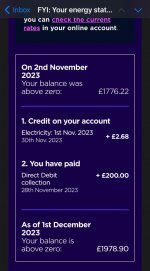
This is probably due to less solar being generated and the batteries in the loft getting minus degree temps. Oh and I’ve noticed my pinroom has the oil radiator coming on a lot more.
Approx 3mth ago my old tariff came to an end with my new overnight one being 9p a kWh.
However strangely this new tariff now gives me 7p per kWh for anything I put back in the grid so my balance just keeps on rising to the point I may as well withdraw funds.
I am now thinking Intelligent octopus may not be for me and I’ll stick with GO.
Anyone else had there tarif changed or use Intelligent octopus.

I’m thinking maybe one of these portable 3kw jobbies anyone have experience of them.
You should just be able to configure your current inverter to charge from the grid during cheap rates at night/day to top up the battery, I do that with mine as my solar output is dire this time of year.
Im on their Cozy tarrif designed for heatpumps that gives a lower rate (16p) between 4am and 7am and then again between 1pm and 4pm which a higher rate the normal between 4pm and 7pm.
Im also on their outgoing octopus tarrif for export that gives 15p per KWh.
Im on their Cozy tarrif designed for heatpumps that gives a lower rate (16p) between 4am and 7am and then again between 1pm and 4pm which a higher rate the normal between 4pm and 7pm.
Im also on their outgoing octopus tarrif for export that gives 15p per KWh.


